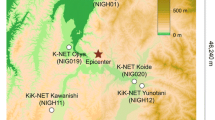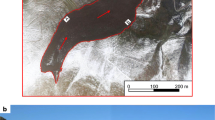Abstract
Detailed landslide susceptibility mapping (LSM) requires a skillful landslide model. Considering that translational landslide is the most type of landslides occurred in the world, a well-behaved translational model is sought. This study presents a simple physically-based distributed translational landslide model. In this model, the incident of landslide is detected from the value of factor of safety (FoS) which is computed based on Mohr–Coulomb failure criterion. In here, FoS is calculated as the ratio of shear strength and shear stress. The lower the FoS, the higher the possibility of a landslide to occur. The model input data consists of soil cohesion \({\varvec{c}}\) (kg/cm2), soil specific weight \({\varvec{\gamma}}\) (g/cm3), depth of surface of rupture (m), slope of surface of rupture \({\varvec{\beta}}\) (degree) and friction angle \(\boldsymbol{\varphi }\) (degree). Application of the model was performed in Sirampog and Kandang Serang, two subdistricts in Western Central Java that underwent the most frequent landslides in the region. Model validation was conducted by comparing the values of FoS of unsaturated and saturated soils and identifying FoS in the sites where landslide events recorded. Several goodness of fit indices to measure the model performance are accuracy (ACC), success index (SI), average index (AI) and distance to perfect classification (D2PC). Under unsaturated condition, the result shows that the number of grids having FoS less than 1 are 0% and 0.6% for Sirampog and Kandang Serang respectively, indicating no landslide occurrence. When the soil gets saturated, 17.6% and 36% of area have FoS less than 1 for Sirampog and Kandang Serang respectively. This shows that the landslide occurred in this region is rainfall-induced landslide. Overall, the model shows a good performance with ACC, SI, AI, D2PC values are 0.82, 0.58, 0.54, 0 and 0.64, 0.49, 0.49, 0 for Sirampog and Kandang Serang respectively.
Access this chapter
Tax calculation will be finalised at checkout
Purchases are for personal use only
Similar content being viewed by others
References
Abedini M, Tulabi S (2018) Assessing LNRF, FR, and AHP models in landslide susceptibility mapping index: a comparative study of Nojian watershed in Lorestan province, Iran. Environ Earth Sci 77(11):405. https://doi.org/10.1007/s12665-018-7524-1
Allen J, Voiland A (2017) A global view of landslide susceptibility. https://earthobservatory.nasa.gov/images/89937/a-global-view-of-landslide-susceptibility
BNPB (2020) Results. https://dibi.bnpb.go.id/DesInventar/results.jsp
Brabb EE (1985) Innovative approaches to landslide hazard and risk mapping, vol 1, pp 17–22
Chang KT, Merghadi A, Yunus AP, Pham BT, Dou J (2019) Evaluating scale effects of topographic variables in landslide susceptibility models using GIS-based machine learning techniques. Sci Rep 9(1):1–21. https://doi.org/10.1038/s41598-019-48773-2
Choi J, Oh HJ, Lee HJ, Lee C, Lee S (2012) Combining landslide susceptibility maps obtained from frequency ratio, logistic regression, and artificial neural network models using ASTER images and GIS. Eng Geol 124(1):12–23. https://doi.org/10.1016/j.enggeo.2011.09.011
Das BM (1994) Principle of foundation engineering. PWS-KENT Publishing Company
Dou J, Yunus AP, Merghadi A, Shirzadi A, Nguyen H, Hussain Y, Avtar R, Chen Y, Pham BT, Yamagishi H (2020) Different sampling strategies for predicting landslide susceptibilities are deemed less consequential with deep learning. Sci Total Environ 720:137320. https://doi.org/10.1016/j.scitotenv.2020.137320
Formetta G, Capparelli G, Versace P (2016) Evaluating performance of simplified physically based models for shallow landslide susceptibility. Hydrol Earth Syst Sci 20:4585–4603. https://doi.org/10.5194/hess-20-4585-2016
Formetta G, Rago V, Capparelli G, Rigon R, Muto F, Versace P (2014) Integrated physically based system for modeling landslide susceptibility. Procedia Earth Planet Sci. https://doi.org/10.1016/j.proeps.2014.06.006
Guimaraes RF, Montgomery DR, Greenberg HM, Fernandes NF, Gomes RAT, de Carvalho Junior OA (2003) Parameterization of soil properties for a model of topographic controls on shallow landsliding: application to Rio de Janeiro. Eng Geol 69(1–2):99–108. https://doi.org/10.1016/S0013-7952(02)00263-6
Hackston A, Rutter E (2016) The Mohr-Coulomb criterion for intact rock strength and friction-a re-evaluation and consideration of failure under polyaxial stresses. Solid Earth 7:493–508. https://doi.org/10.5194/se-7-493-2016
Knowling MJ, White JT, Moore CR (2019) Role of model parameterization in risk-based decision support: an empirical exploration. Adv Water Resour 128:59–73. https://doi.org/10.1016/j.advwatres.2019.04.010
Kuriakose SL, van Beek LPH, van Westen CJ (2009) Parameterizing a physically based shallow landslide model in a data poor region. Earth Surf Process Landf 34(6):867–881. https://doi.org/10.1002/esp.1794
Labuz JF, Zang A (2012) Mohr-Coulomb failure criterion. Rock Mech Rock Eng 45(6):975–979. https://doi.org/10.1007/s00603-012-0281-7
Lakmali ABK, Raveendra HB, Priyankara N (2016) Rain induced landslides in Sri Lanka. Civil and Environmental Engineering Society. https://www.researchgate.net/publication/308722373_RAIN_INDUCED_LANDSLIDES_IN_SRI_LANKA, 5 Jan 2016
Lombardo L, Mai PM (2018) Presenting logistic regression-based landslide susceptibility results. Eng Geol. https://doi.org/10.1016/j.enggeo.2018.07.019
Minnesota Department of Transportation (2019) Manual—MnDOT pavement design. Minnesota Department of Transportation. https://www.dot.state.mn.us/materials/pvmtdesign/manual.html, July 2019
Pawluszek K, Borkowski A, Tarolli P (2018) Sensitivity analysis of automatic landslide mapping: numerical experiments towards the best solution. Landslides 15(9):1851–1865. https://doi.org/10.1007/s10346-018-0986-0
Postance B, Hillier J, Dijkstra T, Dixon N (2018) Comparing threshold definition techniques for rainfall-induced landslides: a national assessment using radar rainfall. Earth Surf Process Landf. https://doi.org/10.1002/esp.4202
Roy J, Saha S (2019) Landslide susceptibility mapping using knowledge driven statistical models in Darjeeling District, West Bengal, India. Geoenviron Disasters 6(1):11. https://doi.org/10.1186/s40677-019-0126-8
Segoni S, Pappafico G, Luti T, Catani F (2020) Landslide susceptibility assessment in complex geological settings: sensitivity to geological information and insights on its parameterization. Landslides 1–11. https://doi.org/10.1007/s10346-019-01340-2
Silalahi FES, Pamela, Arifianti Y, Hidayat F (2019) Landslide susceptibility assessment using frequency ratio model in Bogor, West Java, Indonesia. Geosci Lett 6(1):10. https://doi.org/10.1186/s40562-019-0140-4
Tien Bui D, Shirzadi A, Shahabi H, Geertsema M, Omidvar E, Clague J, Thai Pham B, Dou J, Talebpour Asl D, Bin Ahmad B, Lee S (2019) New ensemble models for shallow landslide susceptibility modeling in a semi-arid watershed. Forests 10(9):743. https://doi.org/10.3390/f10090743
Author information
Authors and Affiliations
Corresponding author
Editor information
Editors and Affiliations
Rights and permissions
Copyright information
© 2021 Springer Nature Switzerland AG
About this chapter
Cite this chapter
Yanto, Sumiyanto, Apriyono, A. (2021). A Simple Physically-Based Distributed Translational Landslide Model. In: Tiwari, B., Sassa, K., Bobrowsky, P.T., Takara, K. (eds) Understanding and Reducing Landslide Disaster Risk. WLF 2020. ICL Contribution to Landslide Disaster Risk Reduction. Springer, Cham. https://doi.org/10.1007/978-3-030-60706-7_8
Download citation
DOI: https://doi.org/10.1007/978-3-030-60706-7_8
Published:
Publisher Name: Springer, Cham
Print ISBN: 978-3-030-60705-0
Online ISBN: 978-3-030-60706-7
eBook Packages: Earth and Environmental ScienceEarth and Environmental Science (R0)




